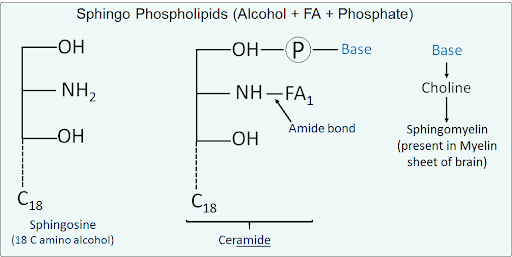Lipids: Classification, Pufas, Ketone Body Synthesis
Apr 25, 2023
Navigate Quickly
Basics
Classification of Lipids
Simple Lipids
Phospholipid (PL)
Cardiolipin
Phospholipids Types
Glycolipids
Types
PUFAs
Polyunsaturated Fatty Acids (PUFAs) means FAs having ≥ 2 double bonds
Categories of PUFAs
Lipid Transport
Lipoproteins
Lipids present in Lipoproteins
Arrangement of lipids in Lipoprotein
Composition of various lipoproteins
High Density Lipoproteins (HDL)
Functions
How HDL adds Fatty acid
Lipoprotein lipase
Ligands on lipoproteins for uptake by liver
Hyperlipoproteinemia (Fredrickson classification)
Fatty Acid Synthesis
FA synthase complex
CITRATE SHUTTLE
Ketone Body Synthesis And Ketone Body Utilisation
Similarities
Differences
Previous Year’s Question
Q. Active metabolite form in synthesis of fatty acid is? (AIIMS Nov 2017)
Q. Major product of fatty acid synthesis is? (AIIMS Nov 2017)
Q. Which of the following is an essential fatty acid? (FMGE JUNE 2018)
Q. Type I hyperlipoproteinemia is characterized by? (NEET Jan 2019)
Q. Ketone bodies are not utilized by? (JIPMER May 2019)
Q. A patient has multiple tendon xanthomas. Serum cholesterol (398 mg/dl) & LDL (220 mg/dl) were found to be raised. Statins were given to this patient. What is the diagnosis? (NEET Sep 2021)
Q. Eicosanoids are formed from? (INICET May 2022)

Lipids are essential biomolecules involved in various physiological processes, including energy storage, cell membrane structure and function, and signalling pathways. A good understanding of lipids is therefore important for understanding how the body functions at a molecular level.
Besides, Lipids are one of the most heavily tested topics in the NEET PG exam, and questions related to lipid metabolism and function carry significant weightage.
Read this blog further to get a quick overview of this high-yield biochemistry topic for NEET PG exam preparations. In this blog we’ll cover classification of lipids, PUFAs, lipoproteins, ketone body synthesis and ketone body utilization.

Basics
Lipid: Any compound which is insoluble in water & soluble in non-polar organic solvent
- Made of fatty acid and alcohol joined by ester bond formed by removal of H2O

Classification of Lipids

Simple Lipids
- Base alcohol is glycerol
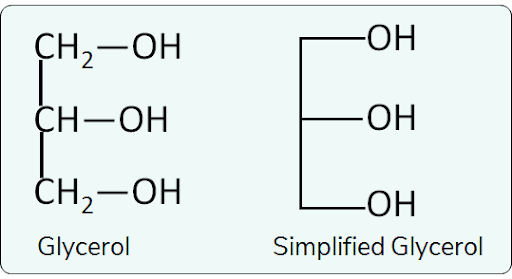

Phospholipid (PL)
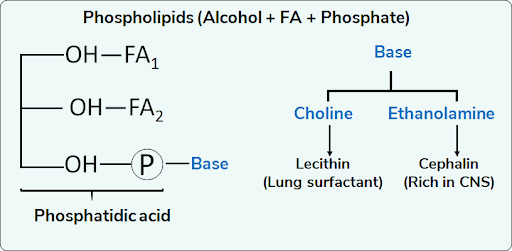
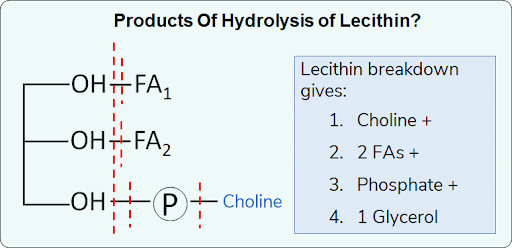
Phospholipases: Enzymes which hydrolyse phospholipids at different places
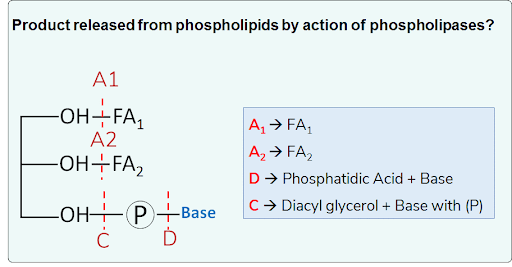
Cardiolipin
- Complex phospholipid
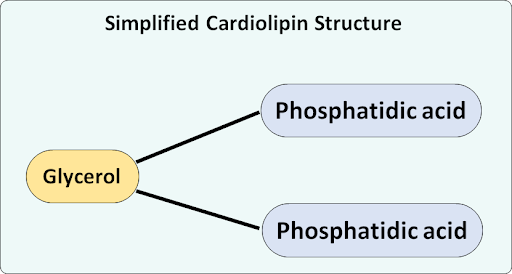
- Phosphatidic acid = Glycerol + 2 FAs + P
- So, product of hydrolysis of cardiolipins = 3 glycerol + 4 FA + 2 P
- Can be antigenic due to its complex nature.
- E.g. Anti-Phospholipid Syndrome
- Occurs due to Anticardiolipin antibodies formed in body
- C/f are thrombotic condition and disease females with history of recurrent abortions
Glycolipids
- Made of Alcohol + FA + Carbohydrate
- Phosphate & base is never present
- Alcohol glycerol is never present
- Alcohol used is sphingosine (so, aka glycosphingolipids)
Types
- Glucosylceramide / Glucocerebrosid
- Sphingosine + FA + glucose
- Sphingosine + FA = ceramide
- Ceramide + Glucose = Glucosylceramide or Glucocerebroside
- Never found in CNS but always found in extra neural tissues
- Sphingosine + FA + glucose
- Galactosylceramide/Galactocerebroside
- Sphingosine + FA + Galactose
- Ceramide + Galactose = Galactosylceramide/ Galactocerebroside
- Always found in CNS
PUFAs
Polyunsaturated Fatty Acids (PUFAs) means FAs having ≥ 2 double bonds
- aka Essential FAs (EFA) - they cannot be synthesized in our body and needs to be essentially taken in diet
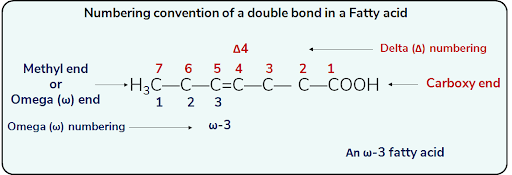
Categories of PUFAs
|
Omega-3 category |
Omega-6 category |
|
|
- Any fatty acid starting from “L” have same number of carbons e.g. α-Linolenic acid, γ–Linolenic acid and Linoleic acid all have 18 carbons
- Smaller Name- Linoleic = 2 double bonds
- Bigger name - Linolenic = 3 double bonds
Important information
- DHA
- is required for brain development of first 2-3 years of life so, Health drinks are fortified with DHA.
- Breast milk always contains DHA.
- α–Linolenic acid is precursor of ω-3 category means if α–Linolenic acid is taken in diet, other two ω-3 FAs can be made form it in the body.
- Linoleic acid is precursor of ω-6 category and can be used to make other two ω-6 FAs in the body
- Most Essential FA is - Linoleic acid as it can make arachidonic acid which is required for PGs and Leukotrienes synthesis.
- PUFAs which are cardioprotective: ω-3 PUFAs
Lipid Transport
- Polar substance is soluble in polar medium and non-polar substance is soluble in non-polar medium
- Transport medium in our body is blood and Blood is water based, hence it is polar
- So, carbohydrate & proteins which are polar can easily dissolve in blood and thus can be easily transported from one place of body to another
- But dietary Lipids due to their non-polar nature cannot be dissolved directly in blood and need special transport structures known as Lipoproteins e.g. HDL, LDL, VLDL
Lipoproteins
Structure
- In Lipoproteins, Lipid is present towards the core surrounded by proteins in the periphery.
Lipids present in Lipoproteins
- Triglyceride ? NP
- Phospholipid ? Amphipathic
- Cholesterol ? Amphipathic
- Cholesterol ester (cholesterol + FA) ? NP
- Proteins are called Apo-proteins

Arrangement of lipids in Lipoprotein
- Non-polar Lipids (TG, Cholesterol ester)
- Present embedded in core
- Amphipathic Lipids (Cholesterol, phospholipids)
- Polar portion will be towards outside
- Non-polar portion will be towards inside
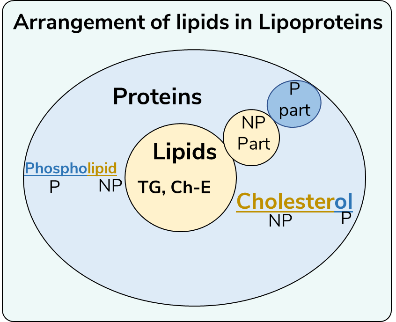
Composition of various lipoproteins
Lipoprotein Lipid present Protein/Apoprotein present Chylomicron TG (exogenous) Apo B48 Chylomicron Remnant TG + Cholesterol Apo B48 + Apo E VLDL TG (endogenous) Apo B100 VLDL Remnant (IDL) TG + Cholesterol Apo B100 + Apo E LDL Cholesterol Apo B100 + Apo E HDL Cholesterol ester Apo-A, Apo-C and Apo-E 

Related Biochemistry Articles:
High Density Lipoproteins (HDL)
Functions
- HDL performs Reverse cholesterol Transport i.e. transport of excess cholesterol from peripheral tissues and blood vessels to Liver
How HDL adds Fatty acid
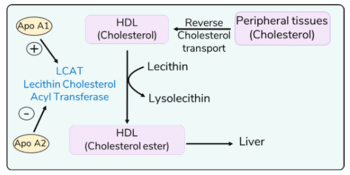
Important Information
- Exogenous TG is transported to peripheral tissues by Chylomicron.
- Endogenous TG is transported from liver to peripheral tissues by: VLDL
- Cholesterol is transported from liver to peripheral tissues by: LDL
- Cholesterol is transported from peripheral tissues to liver by: HDL
Lipoprotein lipase
- Anabolic enzyme present in endothelium cells
- Breaks TG present in chylomicrons and VLDL to convert them to their remnants.
Ligands on lipoproteins for uptake by liver
- Ligands are proteins present on lipoprotein by which liver will recognise particular Lipoprotein
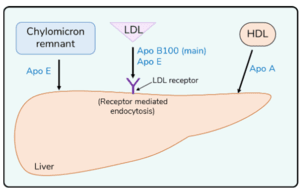
Hyperlipoproteinemia (Fredrickson classification)
|
Type |
Defect |
LP |
TG |
Ch |
Common names |
|
I |
Lipoprotein Lipase Or Apo C-II defect |
Chylo > VLDL |
↑ |
Normal |
Familial Hyperchylomicronemia |
|
II a |
LDL Receptor or Apo B100 |
↑ LDL |
N |
↑ |
Familial Hypercholesterolemia |
|
II b |
Unknown |
↑ VLDL ↑ LDL |
↑ |
↑ |
Familial combined hyperlipoproteinemia |
|
III |
apo E |
↑ Chylo–remnant ↑ VLDL remnant |
↑ |
↑ |
Broad β diseases / Dys β lipoproteinemia |
Important Information
Clinical Features recognition to tackle hyperlipoproteinemia related clinical questions
- Tendon xanthoma ↑ Cholesterol
- Eruptive xanthoma ↑ TG
- Palmar & Tubero eruptive xanthoma ↑ Chylo-remnant & ↑ VLDL remnant
- Milky plasma ↑ Chylomicrons
- Acute pain in abdomen [Acute pancreatitis] ↑ TG
Important Information
Lipoprotein ‘x’
- Abnormal Lipoprotein found in two conditions:
- LCAT deficiency
- Cholestatic states
- Rich in amphipathic lipids (PL & cholesterol)
- Poor in neutral lipids (TG & cholesterol ester)
Fatty Acid Synthesis
Characteristics
- Anabolic pathway
- Occurs in cytoplasm
- Activated by Insulin

FA synthase complex
- Main enzyme and a multienzyme complex (6 enzyme activities)
- Dimer (composed of 2 identical subunits)
Important Information
Q. FA is synthesized from?
Ans: Acetyl Co A and not malonyl CoA
- Because extra Carbon of Malonyl CoA is not getting added in newly synthesized FA
- 1st enzyme carboxylase adds one CO2 to form malonyl CoA but 2nd enzyme FA synthase removes the CO2. So, only CO2 of acetyl CoA are used.
- But, Main Donor of carbon for fatty acid synthesis – Malonyl CoA
CITRATE SHUTTLE
- Used for the transport of Acetyl CoA from mitochondria to cytoplasm for fatty acid synthesis
- Provides two things for FA synthesis
- Acetyl CoA
- NADPH

Ketone Body Synthesis And Ketone Body Utilisation
Similarities
- Both are catabolic pathway
- Both occur in mitochondria
- Both are activated by glucagon and inhibited by insulin
Differences
- KB synthesis occurs only in Liver whereas KB utilization occurs in vital organs brain and heart & also in muscles but never occurs in liver.


Note: In the first step of KB utilization, high energy CoA is added without using ATP. So, the rule of business (i.e. activation using ATP) is not followed.
Important information
- Thiolase is a common enzyme for 4 lipid metabolic pathways
- Ketone body synthesis
- Ketone body utilization
- Cholesterol synthesis
- β-oxidation of FA
- Liver cannot use ketone bodies as it lacks Thiophorase.
Previous Year’s Question
Q. Active metabolite form in synthesis of fatty acid is? (AIIMS Nov 2017)
- Acetyl CoA
- Malonyl CoA
- Stearate
- Palmitate
Q. Major product of fatty acid synthesis is? (AIIMS Nov 2017)
- Acetyl CoA
- ATP
- Citrate
- Palmitate
Q. Which of the following is an essential fatty acid? (FMGE JUNE 2018)
- Citric acid
- Linoleic acid
- Stearic acid
- Palmitic acid
Q. Type I hyperlipoproteinemia is characterized by? (NEET Jan 2019)
- Elevated LDL
- Elevated HDL
- Elevated lipoprotein lipase
- Elevated chylomicrons.
Q. Ketone bodies are not utilized by? (JIPMER May 2019)
- Brain
- RBC
- Heart
- Skeletal muscle
Q. A patient has multiple tendon xanthomas. Serum cholesterol (398 mg/dl) & LDL (220 mg/dl) were found to be raised. Statins were given to this patient. What is the diagnosis? (NEET Sep 2021)
- Lipoprotein lipase deficiency
- Familial hypercholesterolemia
- Tangier’s disease
- Huntington’s disease
Q. Eicosanoids are formed from? (INICET May 2022)
- Arachidonic acid
- Platelet aggregation
- 4 fused rings
- Arginine
To study this topic in further detail, head over to the PrepLadder app and learn from comprehensive video lectures by India’s top medical faculty.


PrepLadder Medical
Get access to all the essential resources required to ace your medical exam Preparation. Stay updated with the latest news and developments in the medical exam, improve your Medical Exam preparation, and turn your dreams into a reality!
Top searching words
The most popular search terms used by aspirants
- NEET PG Biochemistry
PrepLadder Version X for NEET PG
Avail 24-Hr Free Trial
